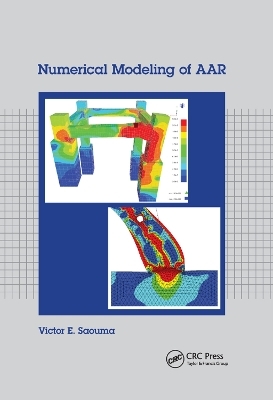
Numerical Modeling of AAR
CRC Press (Verlag)
978-1-138-07470-5 (ISBN)
Subjects treated are:
• Brief overview of AAR: nature of the chemical reactions, AAR in both dams and nuclear power plants, and how does it impact the mechanical properties of concrete.
• Constitutive model for both the AAR expansion, and concrete nonlinearities (both smeared and discrete crack models).
• Validation of the model along with a parametric study to assess what are the critical parameters in a study.
• Selection of material properties for an AAR finite element simulation, followed by applications in dams and massive reinforced concrete structures.
• Micro Model for improved understanding of the essence of the reaction, along with a newly proposed mathematical model for the kinetics of the reaction.
• Review of relevant procedures to estimate the residual expansion of a structure suffering from AAR, along with a proposed approach to determine when the reaction will end.
The book is extensively illustrated with numerous figures and provides guidance to engineers confronted with swelling in concrete infrastructures.
Victor E. Saouma is a professor of civil engineering at the University of Colorado Boulder . He joined the department in 1984 where he teaches courses in structural analysis. He is currently president of the International Association of Fracture Mechanics for Concrete and Concrete Structures (IA-FraMCoS) and was formerly the director of the University of Colorado Fast Hybrid Testing Laboratory which is part of the George E. Brown, Jr. Network for Earthquake Engineering Simulation. Over the years his research interests have varied but are always driven by a desire to apply first principles toward the solution of engineering problems. This has included innovative experimental work such as centrifuge/shake table tests of dams and real time hybrid simulation of reinforced concrete frames, as well as development of constitutive models, development of nonlinear finite element codes, modeling of concrete. His research has primarily been funded by EPRI (Electric Power Research Company), TEPCO (Tokyo Electric Power Company), and government agencies such as the National Science Foundation and the Oak Ridge National Laboratory. As a consultant, his work has involved the seismic safety of very high arch dams, delamination in nuclear power plants, and AAR induced damage in infrastructures. He has over eighty peer-reviewed journal articles.
Preface
1 Introduction
1.1 Concrete Composition
1.2 Alkali Aggregate Reactions
1.3 A Brief Review of Finite Element
1.4 A Brief Review of Heat Transfer
1.5 Finite Element Modeling of AAR
1.6 Book Content
1.7 Summary
2 AAR Constitutive Model
2.1 Minimum Requirements for a "Modern" AAR Numerical Model .
2.2 The Model
2.3 Kinetics
2.4 Retardation
2.5 Humidity
2.6 AAR Strain
2.7 Summary
3 Constitutive Model; Concrete
3.1 Introduction
3.2 Nonlinear response of concrete
3.3 The nonlinear continuum model
3.4 Nonlinear Discrete Joint Element
3.5 Summary
4 Validation
4.1 Benchmark Results
4.2 Summary
5 Parametric Study
5.1 Preliminary
5.2 Results
5.3 Summary
6 Material Properties
6.1 Introduction
6.2 Elastic properties
6.3 AAR properties
6.4 Thermal properties
6.5 Reclamation study
6.6 AAR properties through system identification
6.7 On the Importance of Proper Calibration
6.8 Summary
7 Applications
7.1 Arch Gravity Dam; Isola
7.2 Hollow Buttress Dam; Poglia
7.3 Arch Dam, Amir-Kabir
7.4 Arch Dam, Kariba
7.5 Massive Reinforced Concrete Structure
7.6 Summary
8 Micro Model
8.1 A Diffusion-Based Micro Model
8.2 A Mathematical Model for the Kinetics of the Alkali-Silica Reaction
8.3 Summary
9 Prediction of Residual Expansion
9.1 Literature Survey
9.2 Expansion Curve from Delayed Laboratory Testing
9.3 Summary
A Numerical Benchmark for the Finite Element Simulation of Expansive Concrete
A.1 Introduction
A.2 Test Problems
A.3 Presentation of Results
A.4 Results Submission and Workshop
A.5 Acknowledgements
A.6 Contacts
B Merlin
B.1 Introduction
B.2 Arch Dam Preprocessor: Beaver
B.3 Preprocessor: KumoNoSu
B.4 Analysis: Merlin
B.5 Post-Processor: Spider
C Brief Review of the Reaction Rate
C.1 Definitions
C.2 Examples of Simple Reactions
C.3 Complex Reactions
Author Index
Index
| Erscheinungsdatum | 21.01.2019 |
|---|---|
| Verlagsort | London |
| Sprache | englisch |
| Maße | 156 x 234 mm |
| Gewicht | 453 g |
| Themenwelt | Technik ► Bauwesen |
| Technik ► Maschinenbau | |
| Technik ► Umwelttechnik / Biotechnologie | |
| ISBN-10 | 1-138-07470-5 / 1138074705 |
| ISBN-13 | 978-1-138-07470-5 / 9781138074705 |
| Zustand | Neuware |
| Haben Sie eine Frage zum Produkt? |
aus dem Bereich


